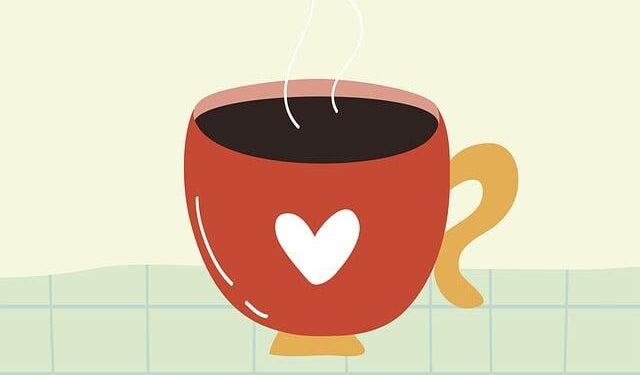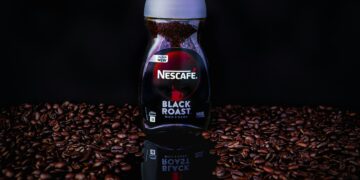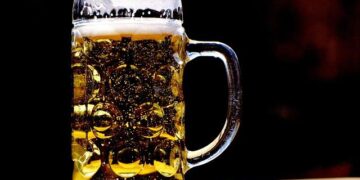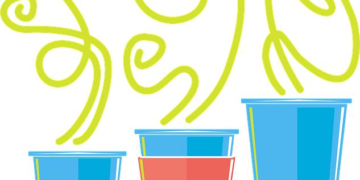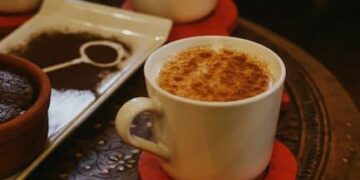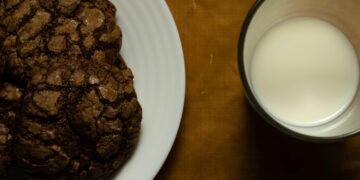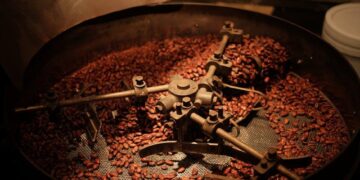Table of Contents
Introduction: The Comforting Conundrum of the Chai Latte
The scene is a familiar one: a customer stands before the glowing menu board of a Starbucks, navigating a sea of options.
They are seeking a reprieve, a moment of calm in a bustling day.
The aggressive jolt of a dark roast or the sharp intensity of an espresso feels like too much.
Their eyes land on a gentler-sounding alternative: the Chai Tea Latte.
The name itself evokes warmth and wellness, conjuring images of aromatic spices like cinnamon, cardamom, and ginger mingling in a creamy, soothing cup.1
It promises comfort, a departure from the high-octane world of coffee.
This beverage has positioned itself as the perfect “gentle” choice, a beverage associated with a mindful pause rather than a frantic push.
This report begins by posing a central question born from this very scenario.
The consumer’s problem is one of profound uncertainty, a potential act of self-deception in the pursuit of well-being.
In choosing the Chai Tea Latte to consciously avoid the perceived intensity of coffee, are they unknowingly consuming a significant, and potentially disruptive, amount of caffeine? This question establishes the core tension of this investigation.
It frames the drink not as inherently good or bad, but as a consumer product with hidden complexities that merit a much closer look.
The appeal of the Chai Latte is deeply rooted in its perception as a non-coffee, tea-based beverage, a categorization that consumers often equate with lower caffeine and a gentler physiological experience.4
The name “Chai
Tea Latte” explicitly places the drink in this “tea” category within the consumer’s mental framework.1
This mental shortcut creates a powerful expectation of a specific caffeine profile—one that is assumed to be substantially lower than that of coffee.5
The conundrum arises when the reality of the product’s formulation and its actual caffeine content clashes with this ingrained consumer expectation, potentially leading to unwanted physiological effects.
This report aims to resolve that dissonance, guiding the consumer from a state of uncertainty to one of confident, informed choice.
I. Deconstructing the Cup: The Anatomy of a Starbucks Chai Tea Latte
To understand the caffeine content of a Starbucks Chai Tea Latte, one must first understand its fundamental construction.
A common misconception is that the beverage is crafted by steeping chai tea bags directly in steamed milk.
The reality is quite different and is the key to unlocking the entire puzzle.
The foundation of every Starbucks Chai Tea Latte, whether hot or iced, is a pre-made, pre-sweetened liquid known as “Chai Tea Concentrate”.7
This concentrate is then combined with milk (and water for the hot version) to create the final drink.8
A deep dive into the official ingredient list for this concentrate reveals its core components.
It is primarily composed of an infusion of water and several key spices and flavorings: cardamom, black pepper, ginger, cinnamon, cloves, natural flavors, and star anise.
Critically, however, the first ingredient in that infusion after water is black tea.7
This single ingredient is the definitive, non-negotiable source of the drink’s caffeine.
The word “chai” itself is the Hindi word for “tea,” and the beverage’s inspiration, traditional masala chai, is fundamentally a black tea-based drink known for its robust, stimulating properties.1
Therefore, the presence of caffeine is not an accident or a minor component; it is integral to the very identity of the product.
Furthermore, the use of a pre-made concentrate introduces another crucial element for the health-conscious consumer.
Examining the ingredient list reveals that sugar and honey are primary components, added directly into the concentrate during its manufacturing.1
A standard Grande (16 oz) Chai Tea Latte contains a striking 42 grams of sugar.7
This structural reality of the drink is of paramount importance.
Unlike a standard brewed coffee or tea where the customer has complete control over sweetness by adding sugar packets themselves, the sweetness in a Chai Tea Latte is “baked in.” This means a customer cannot simply order an “unsweetened Chai Tea Latte” if the barista is using the standard concentrate, a frequent point of confusion and frustration.3
This reframes the consumer’s “problem” from a simple question about caffeine to a more complex, dual-intake issue.
The standard order delivers not just a stimulant but also a high dose of sugar, with very limited control over either.
This fact is central to understanding not only what is in the cup, but also how to effectively modify it to meet personal health goals, a topic that will be explored in detail later in this report.
II. The Caffeine Verdict: A Quantitative Analysis
With the source of the caffeine identified as the black tea in the Chai Concentrate, the next step is to quantify it.
The answer is unequivocal: Yes, a Starbucks Chai Tea Latte contains a moderate to significant amount of caffeine, with the precise amount varying by size.
This consistency is achieved through a standardized preparation method used by baristas worldwide: the “pump” system.12
The Chai Concentrate is dispensed from a large container using a calibrated pump, ensuring that each drink size receives a specific, repeatable volume of the concentrate.2
Consequently, the caffeine content of a Chai Latte is directly proportional to the number of pumps used.
The standard recipes for hot and iced versions differ slightly in their pump allocations, which in turn affects the final caffeine tally, particularly for the largest sizes.
The standard pump counts are as follows 12:
- Hot Drinks:
- Short (8 oz): 2 pumps
- Tall (12 oz): 3 pumps
- Grande (16 oz): 4 pumps
- Venti (20 oz): 5 pumps
- Iced Drinks:
- Tall (12 oz): 3 pumps
- Grande (16 oz): 4 pumps
- Venti (24 oz): 6 pumps
This pump-based system provides a powerful tool for understanding and controlling caffeine intake.
Analysis of Starbucks’ own nutritional data reveals that a Grande Chai Latte, which contains 4 pumps of concentrate, has 95 milligrams (mg) of caffeine.7
This allows for a critical calculation: if 4 pumps deliver 95 mg of caffeine, then each individual pump of Chai Concentrate contains approximately 23.75 mg of caffeine.9
This “per-pump” caffeine value is the key that unlocks true customization.
It transforms the abstract concept of a “pump” into a tangible, measurable unit of caffeine dosage.
A consumer armed with this knowledge can precisely titrate their caffeine intake by simply requesting a different number of pumps, a strategy that will be detailed in the solutions section of this report.
To provide a clear and authoritative reference, the caffeine content for each standard size of the Starbucks Chai Tea Latte is consolidated below.
This table synthesizes data from official Starbucks sources and reputable industry analyses to eliminate the confusion that can arise from conflicting online information.12
| Drink Size | Serving Size (oz) | Standard Pumps | Caffeine (mg) |
| Short (Hot Only) | 8 | 2 | 50 |
| Tall (Hot & Iced) | 12 | 3 | 70 |
| Grande (Hot & Iced) | 16 | 4 | 95 |
| Venti (Hot) | 20 | 5 | 120 |
| Venti (Iced) | 24 | 6 | 120 |
Data synthesized from official Starbucks nutrition information and multiple industry analyses.12
The caffeine content for the Venti Iced (6 pumps) is often listed as 120 mg, the same as the Venti Hot (5 pumps), suggesting a potential cap or rounding in official reporting.
III. Placing Chai in the Caffeinated Universe: A Comparative Perspective
The figure of 95 mg of caffeine in a Grande Chai Tea Latte is, in isolation, a meaningless number.
Its true significance for the consumer is only revealed through context and comparison.
To understand if this amount is “high” or “low,” it must be benchmarked against the broader landscape of popular caffeinated beverages.
This comparative analysis reveals that the Starbucks Chai Tea Latte occupies a unique and potentially deceptive “caffeine middle-ground.”
On one hand, when compared to Starbucks’ signature brewed coffees, the Chai Latte appears to be a significantly lower-caffeine option.
A Grande Pike Place Roast, for example, contains approximately 310 mg of caffeine.12
From this perspective, a consumer choosing a 95 mg Chai Latte over a 310 mg coffee is indeed reducing their caffeine intake by nearly 70%, seemingly validating their decision to opt for a “gentler” beverage.
However, the story changes dramatically when the comparison shifts.
The assumption that a “tea latte” would have caffeine levels similar to a simple cup of tea is incorrect.
A Grande Teavana Chai brewed from a tea bag at Starbucks contains only about 40 mg of caffeine.13
This means the standard Chai Latte, made from concentrate, has more than double the caffeine of its tea-bag counterpart.
The comparison to other common beverages is equally revealing.
A 12 oz can of Coca-Cola contains about 34 mg of caffeine, and an 8.4 oz can of Red Bull contains 80 mg.6
This places the Grande Chai Latte’s 95 mg dose well above these common benchmarks.
Perhaps the most startling and counter-intuitive comparison is with espresso.
A single shot of Starbucks espresso, the potent heart of drinks like lattes and cappuccinos, contains approximately 75 mg of caffeine.9
This means that a standard Grande Chai Tea Latte contains more caffeine than a solo shot of espresso.
Furthermore, a Grande Caffè Latte, which contains two shots of espresso, has about 150 mg of caffeine.9
The Chai Latte, at 95 mg, sits squarely between a single-shot and a double-shot espresso drink in terms of potency.
This “middle-ground” status is the very source of the consumer conundrum.
The drink is a “low-caffeine” choice relative to the high benchmark of Starbucks’ brewed coffee, which aligns with consumer expectations.
Simultaneously, it is a “high-caffeine” choice relative to what most people perceive as “tea” and is even more caffeinated than a shot of espresso, which defies those same expectations.
This duality explains why a beverage sought for its gentle qualities can sometimes produce surprisingly potent stimulating effects.
IV. The Personal Equation: Why 95 Milligrams Matters Differently to Everyone
The analysis thus far has focused on the objective, quantifiable aspects of the beverage itself.
However, the true impact of a Chai Latte marks a crucial pivot from the drink to the drinker.
The “problem” is ultimately not defined by the 95 mg of caffeine in the cup, but by the unique and complex interaction between those 95 milligrams and an individual’s specific physiology, psychology, and daily habits.
The Spectrum of Sensitivity
The experience of consuming caffeine is not universal.
The reason one person can drink an espresso after dinner and sleep soundly while another feels jittery after a morning cup of tea lies in caffeine sensitivity.
This trait is largely governed by two genetic factors: variations in the ADORA2A gene, which affects how strongly caffeine binds to receptors in the brain, and the efficiency of a liver enzyme called CYP1A2, which determines how quickly the body metabolizes and eliminates caffeine.19
This genetic lottery places individuals on a spectrum of sensitivity 19:
- Hyposensitivity: A small portion of the population carries a gene linked to higher caffeine intake. They metabolize caffeine very efficiently and can consume large amounts with little to no effect, even late in the day.19
- Normal Sensitivity: The majority of people fall into this category. They can typically consume up to 400 mg of caffeine daily—the general limit recommended by health authorities like the FDA—without significant adverse effects.19
- Hypersensitivity: Individuals with high sensitivity to caffeine metabolize it very slowly. For them, even a small dose can produce the effects that a normal-sensitivity person might experience only at high doses. A single Grande Chai Latte could cause a hypersensitive person to experience a racing heart, anxiety, restlessness, and insomnia for several hours.19
The Tolerance Trap
Beyond innate sensitivity, the body’s response to caffeine is also shaped by habit.
Regular, daily consumption leads to the development of tolerance.
Caffeine works primarily by blocking adenosine, a neurotransmitter that builds up during the day and signals tiredness.22
To compensate for this constant blockade, the brain begins to create more adenosine receptors.24
The result is that the regular drinker’s baseline level of alertness shifts.
They now require their daily dose of caffeine just to overcome the increased number of receptors and reach a “normal” level of wakefulness.24
This can create a vicious cycle of dependence.
A person might use a Chai Latte to feel alert, but the caffeine disrupts their sleep that night.
This leads to fatigue the following day, which increases their perceived need for another caffeinated beverage to function.22
If they try to stop, they can experience withdrawal symptoms, including debilitating headaches, profound fatigue, muscle pain, and irritability.24
The Caffeine-Anxiety Connection
For many, the Chai Latte is a comforting ritual, a tool to soothe stress.
Paradoxically, for some individuals, it can become a source of the very anxiety it was meant to alleviate.
Caffeine is a powerful central nervous system stimulant that triggers the release of adrenaline, the body’s “fight-or-flight” hormone.26
The physiological cascade that follows includes an increased heart rate, faster breathing, and heightened alertness—symptoms that are clinically indistinguishable from those of an anxiety or panic attack.28
The brain can struggle to differentiate between a caffeine-induced state of arousal and a state of genuine anxiety, which can trigger or worsen anxious feelings in those who are already susceptible.30
This connection is so well-established that the Diagnostic and Statistical Manual of Mental Disorders (DSM-5), the authoritative guide for psychiatric diagnoses, officially recognizes “Caffeine-Induced Anxiety Disorder” as a clinical condition.27
For a person with an underlying anxiety disorder, the 95 mg of caffeine in a Grande Chai Latte could be enough to tip them from a state of calm into one of unease and physical distress.
The Sleep Saboteur
Perhaps the most insidious effect of caffeine is its impact on sleep.
By blocking adenosine receptors, caffeine directly interferes with the body’s primary mechanism for inducing sleepiness.19
Its effects are long-lasting; caffeine has a half-life of about 4-6 hours, meaning that half the dose is still circulating in the body that long after consumption.33
Research shows that caffeine consumed even six to eight hours before bedtime can have a significant disruptive effect on sleep.22
It can delay the onset of sleep, reduce total sleep time, and, most importantly, decrease the amount of deep, restorative slow-wave sleep.
This is the stage of sleep critical for physical repair and feeling refreshed.
A person might fall asleep and stay asleep for eight hours, but the quality of that sleep is compromised, leading them to wake up feeling tired and unrefreshed, thus perpetuating the cycle of needing a stimulant to start the day.22
The comforting ritual of an afternoon Chai Latte can, therefore, become a hidden driver of chronic, low-grade physiological and psychological stress.
The temporary mood lift from the sugar and caffeine can give way to anxiety-like symptoms, which then leads to disrupted sleep, followed by next-day fatigue.
The very beverage sought for comfort can become a key contributor to the exact conditions—anxiety and fatigue—it was meant to resolve.
V. The Empowered Order: A Guide to Crafting Your Perfect Chai
Having fully defined the multifaceted “problem” of the Starbucks Chai Tea Latte—its hidden caffeine, high sugar content, and potential to disrupt well-being—this report now provides the comprehensive “solution” toolkit.
The goal is to transform the reader from a passive recipient of a standardized product into an empowered consumer who can confidently navigate the menu and customize their order to align perfectly with their personal health goals.
Solution 1: The Low-Caffeine, Low-Sugar Gold Standard
For the consumer seeking the flavor profile of chai with maximum control over caffeine and sugar, this is the ultimate order.
- The Order: “Can I please have a Grande Custom Hot Tea Latte with one Chai tea bag and [your milk of choice]?”
- The Method: This order bypasses the pre-sweetened concentrate entirely. The barista will steep a Teavana Chai tea bag (which contains black tea and spices but no sugar) in hot water, then add steamed milk to create a true latte.3
- The Outcome: This beverage delivers a much lower caffeine dose of approximately 40 mg.13 Crucially, it contains zero grams of added sugar from a concentrate. The customer has full control to add their preferred amount and type of sweetener—or none at all—at the condiment bar.10 This is the definitive “hack” for the health-conscious individual who wants to enjoy the essence of chai without the high load of sugar and moderate caffeine.
Solution 2: The Caffeine & Sugar Reduction
For those who enjoy the specific creamy texture and flavor of the standard concentrate-based latte but wish to moderate their intake, this is the ideal strategy.
- The Order: “Can I please have a Grande Iced Chai Latte with almond milk and only two pumps of chai?”
- The Method: This approach leverages the “caffeine per pump” knowledge. By explicitly requesting a specific number of pumps, the customer takes direct control of the recipe. Asking for two pumps in a Grande instead of the standard four is a common and easily accommodated request.12
- The Outcome: This simple modification cuts both the caffeine and sugar content by 50%. The resulting drink contains approximately 47.5 mg of caffeine and 21 grams of sugar. It maintains the familiar flavor and mouthfeel of the original latte but in a significantly more moderate and manageable form.
Solution 3: The “Dirty Chai” – The High-Caffeine Option
It is also important to understand how to increase caffeine, if desired, to avoid accidentally ordering a more potent drink than intended.
- The Order: “A Grande Dirty Chai Latte.”
- The Method: This is a popular off-menu item that consists of a standard Chai Latte with one or more shots of espresso added.1
- The Outcome: This order significantly increases the total caffeine. A Grande Dirty Chai with a single shot of espresso contains approximately 170 mg of caffeine (95 mg from the chai concentrate plus 75 mg from the espresso shot).12 This makes it a potent beverage, stronger than a standard Caffè Latte.
To consolidate these strategies into a practical, at-a-glance tool, the following customization matrix can be used to match a personal health goal with the exact language needed to place the order.
| Your Goal | The Exact Order to Place | Approx. Caffeine (Grande) | Approx. Added Sugar (Grande) | Key Benefit |
| Lowest Caffeine & Sugar | “Grande Custom Hot Tea Latte with one chai tea bag and [milk of choice].” | ~40 mg | 0 g | Complete control over sweetness and lowest caffeine. |
| Reduced Caffeine & Sugar | “Grande Iced Chai Latte with 2 pumps of chai and [milk of choice].” | ~47.5 mg | ~21 g | Maintains original flavor with 50% less caffeine and sugar. |
| The Standard Experience | “Grande Chai Tea Latte.” | 95 mg | 42 g | The original, unmodified recipe. |
| Maximum Caffeine Boost | “Grande Dirty Chai Latte with one shot of espresso.” | ~170 mg | 42 g | A powerful combination of coffee and spice flavors. |
Conclusion: Mindful Indulgence in a Caffeinated World
This investigation began with a simple question about a beloved comfort drink and embarked on a journey deep into the heart of its composition.
We moved from a state of uncertainty, where the Starbucks Chai Tea Latte existed as a vaguely “gentle” alternative to coffee, to a place of clarity.
We have uncovered its hidden complexities: its reliance on a pre-made, black-tea-based concentrate, its moderate-to-significant caffeine content, and its surprisingly high dose of sugar.
We have explored the profound and deeply personal ways this specific formulation can interact with our unique physiology, influencing everything from anxiety levels to the very architecture of our sleep.
Finally, we have arrived at a place of empowered, mindful choice, armed with the precise knowledge and language needed to craft the perfect cup.
The central theme of this report is not to demonize the Chai Tea Latte or to advocate for its removal from one’s routine.
Rather, it is a call for mindful consumption.
The evidence suggests that true wellness is not found in rigid restriction but in genuine understanding.
The standard Grande Chai Tea Latte, with its 95 mg of caffeine and 42 grams of sugar, is a specific product with a specific profile.
For some, on some occasions, it may be exactly what is desired.
For others, particularly those sensitive to caffeine, managing anxiety, or prioritizing sleep, it may be a source of unintended consequences.
The ultimate empowerment comes from recognizing this and knowing that alternatives exist.
By deconstructing our daily habits and understanding the “what” and “why” behind the products we consume, we can make small, informed adjustments that yield a significant positive impact on our overall health.
The knowledge that one can request a brewed tea bag latte to eliminate added sugar, or ask for half the number of pumps to cut the caffeine, transforms a simple coffee run from a passive transaction into a proactive act of self-awareness and self-care.
It allows the consumer to enjoy the comforting ritual of a chai latte, but to do so entirely on their own terms.
Works cited
- Starbucks Chai Tea Latte Recipe (Copycat) – Bites with Bri, accessed August 3, 2025, https://biteswithbri.com/chai-latte-tea-starbucks/
- Iced Chai Latte: Starbucks Coffee Company, accessed August 3, 2025, https://www.starbucks.com/menu/product/466/iced
- How to order a chai tea latte at Starbucks – Quora, accessed August 3, 2025, https://www.quora.com/How-do-I-order-a-chai-tea-latte-at-Starbucks
- Caffeine compared: from coke and coffee to aspirin and chocolate – The Guardian, accessed August 3, 2025, https://www.theguardian.com/news/2013/nov/27/caffeine-compared-coke-coffee-aspirin-chocolate-tea
- Caffeine content of common beverages – PubMed, accessed August 3, 2025, https://pubmed.ncbi.nlm.nih.gov/762339/
- How Much Caffeine Is In Coffee vs Tea vs Soda, accessed August 3, 2025, https://coffeebros.com/blogs/coffee/how-much-caffeine-is-in-coffee-vs-tea-vs-soda
- Iced Chai Latte: Nutrition: Starbucks Coffee Company, accessed August 3, 2025, https://www.starbucks.com/menu/product/466/iced/nutrition
- Chai Latte: Nutrition: Starbucks Coffee Company, accessed August 3, 2025, https://www.starbucks.com/menu/product/466/hot/nutrition
- Caffeine or no caffeine in the Chai? : r/starbucks – Reddit, accessed August 3, 2025, https://www.reddit.com/r/starbucks/comments/a5kkgv/caffeine_or_no_caffeine_in_the_chai/
- How to order an unsweetened chai tea latte in Starbucks – Quora, accessed August 3, 2025, https://www.quora.com/How-can-I-order-an-unsweetened-chai-tea-latte-in-Starbucks
- How can I order a Starbucks skinny iced chai latte in the app – Reddit, accessed August 3, 2025, https://www.reddit.com/r/starbucks/comments/1e3yc8m/how_can_i_order_a_starbucks_skinny_iced_chai/
- Amount of Caffeine in Starbucks Chai Latte: Suprising Number – coffee, accessed August 3, 2025, https://coffeefactz.com/amount-of-caffeine-in-starbucks-chai-latte/
- Does Starbucks Chai Tea Have Caffeine? What to Know! | Corner Coffee Store, accessed August 3, 2025, https://cornercoffeestore.com/does-starbucks-chai-tea-have-caffeine/
- Chai Latte: Starbucks Coffee Company, accessed August 3, 2025, https://www.starbucks.com/menu/product/466/hot
- Chai Tea Latte | Starbucks Australia, accessed August 3, 2025, https://www.starbucks.com.au/product/chai-tea-latte/
- Does Starbucks Chai Tea Have Caffeine? – Foodzilla, accessed August 3, 2025, https://foodzilla.com/questions/does-starbucks-chai-tea-have-caffeine
- Coffee, Tea, Soft Drinks — Caffeine Content – Math.Utah.Edu, accessed August 3, 2025, https://www.math.utah.edu/~yplee/fun/caffeine.html
- How much caffeine is in coffee, tea, soda, and other foods?, accessed August 3, 2025, https://www.cspi.org/article/how-much-caffeine-coffee-tea-soda-and-other-foods
- Caffeine Sensitivity: Symptoms, Causes, and Diagnosis – Healthline, accessed August 3, 2025, https://www.healthline.com/health/caffeine-sensitivity
- Caffeine: How much is too much? – Mayo Clinic, accessed August 3, 2025, https://www.mayoclinic.org/healthy-lifestyle/nutrition-and-healthy-eating/in-depth/caffeine/art-20045678
- Caffeine sensitivity: Symptoms, causes, and management – Medical News Today, accessed August 3, 2025, https://www.medicalnewstoday.com/articles/caffeine-sensitivity
- Caffeine and Sleep Problems – Sleep Foundation, accessed August 3, 2025, https://www.sleepfoundation.org/nutrition/caffeine-and-sleep
- Does Caffeine Cause Nervousness? Stop? – FOMAT Medical Research, accessed August 3, 2025, https://www.fomatmedical.com/news-posts/does-caffeine-cause-nervousness-stop/
- How Long Does It Take for Caffeine Tolerance to Occur? – MedicineNet, accessed August 3, 2025, https://www.medicinenet.com/how_long_does_it_take_caffeine_tolerance_to_occur/article.htm
- Caffeine Tolerance: How Much Coffee Is Too Much? – Ratio Coffee, accessed August 3, 2025, https://ratiocoffee.com/blogs/coffee-guides/caffeine-tolerance-how-much-coffee-is-too-much
- Caffeine | Better Health Channel, accessed August 3, 2025, https://www.betterhealth.vic.gov.au/health/healthyliving/caffeine
- 9 Side Effects of Too Much Caffeine – Healthline, accessed August 3, 2025, https://www.healthline.com/nutrition/caffeine-side-effects
- Does Caffeine Cause Anxiety? – Baptist Health, accessed August 3, 2025, https://www.baptisthealth.com/blog/family-health/does-caffeine-cause-anxiety
- What to Do When You’ve Had Too Much Caffeine – Right as Rain by UW Medicine, accessed August 3, 2025, https://rightasrain.uwmedicine.org/body/food/too-much-caffeine
- Everything You Need To Know About Anxiety and Caffeine – Health, accessed August 3, 2025, https://www.health.com/condition/anxiety/how-coffee-increases-anxiety
- Does caffeine cause anxiety? – Medical News Today, accessed August 3, 2025, https://www.medicalnewstoday.com/articles/anxiety-and-caffeine
- Caffeine-induced anxiety disorder – Wikipedia, accessed August 3, 2025, https://en.wikipedia.org/wiki/Caffeine-induced_anxiety_disorder
- Caffeine – University Health Services, accessed August 3, 2025, https://uhs.princeton.edu/health-resources/caffeine
- Healthy Dirty Chai Tea Latte Starbucks Order: 80 Cals | Lauren Gleisberg, accessed August 3, 2025, https://laurengleisberg.com/healthy-starbucks-drink-order-dirty-chai-tea-latte/
- Starbucks Healthy Drink Swap: Dirty Iced Chai Latte – YouTube, accessed August 3, 2025, https://www.youtube.com/watch?v=5RRJbua73F0
